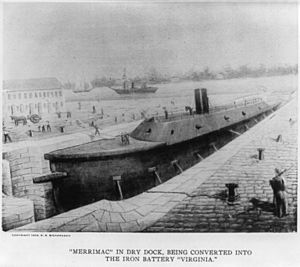Mary Louvestre facts for kids
Mary Louvestre was a brave African-American woman who worked as a spy for the Union during the US Civil War. She lived in Norfolk, Virginia. Mary played a very important role by secretly sharing information about a powerful new warship the Confederates were building. This ship was the USS Merrimack, which they turned into an "ironclad" called the CSS Virginia. Ironclads were ships covered in metal, making them very strong against cannon fire.
Contents
Mary Louvestre's Story
There are a few different stories about Mary Louvestre's life and how she became a spy. One story comes from official papers written by Gideon Welles, who was the Secretary of the Navy for the Union.
An Account from Secretary Welles
In this version, Mary Louvestre worked with another Union spy named William H. Lyons. Lyons was one of the few workers at Norfolk's Gosport Navy Yard who stayed behind after the Confederate Army took over Norfolk. He kept sending information to the Union through contacts at Fort Monroe. Secretary Welles said that Mary Louvestre came to him secretly in February 1862. She brought important documents about the CSS Virginia that she had received from Lyons.
A More Detailed Story
Another story about Mary Louvestre gives us more details about her life. This account comes from a novel by G. Allen Foster and a history by Benjamin Arthur Quarles. Many other sources have repeated parts of this story.
Early Life and Skills
In this version, Mary Louvestre was born in the Shenandoah Valley. When she was a young teenager, a small farmer bought her. During the Civil War, she might have been between 55 and 70 years old. Mary was very good at drawing and tracing. Because of this special skill, she was taught to sew and became a seamstress.
After two difficult years on the farm, Mary was sold again. She was bought by a relative of her owner, Simeon or John Louvestre, who lived in Norfolk.
Discovering the Secret Plans
By July 1861, Mary had earned enough money from her seamstress work to buy her freedom. She overheard her employer, who worked at the Gosport Navy Yard in Norfolk. He was an engineer or a supplier for ships. He was bragging about a new ironclad ship they were building. This ship was the Merrimack, which was later renamed the CSS Virginia. He claimed it would be so powerful that it would defeat the Union Navy.
For the next week, Mary secretly went into the engineers' office early in the mornings. She used her skills as a seamstress to carefully trace the drawings of the ironclad ship.
Delivering the Information
To get her secret information to the Union leaders, Mary asked for permission to visit her former owners in the valley. With a special pass in hand, she headed towards the Union lines near Fredericksburg. With help from the Underground Railroad, she reached her destination safely.
From there, soldiers escorted her to Washington, D.C.. In Washington, she met with Gideon Welles, the Secretary of the Navy. Welles offered Mary her freedom and a job, but Mary chose to return to Norfolk and wait for freedom there. The information Mary provided was very important. The Union used it to quickly finish their own ironclad ship, the USS Monitor. The USS Monitor later fought the CSS Virginia and helped protect Union ships from its powerful attacks.
Another book about her story, The Treason of Mary Louvestre by My Haley, was published in 2013. This book is similar to the story told by Foster.
Personal Life
Mary Louvestre was married to Michael Louvestre. She was also known to be a Catholic.


